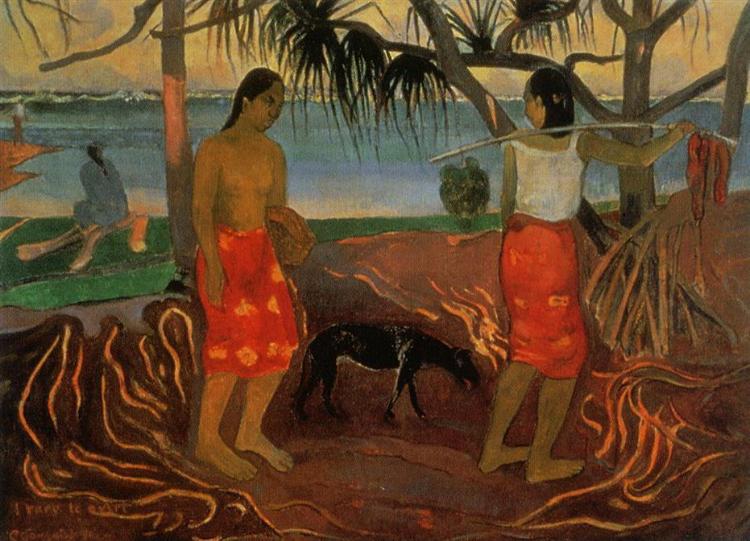Beschreibung
Paul Gauguin's painting "Under the Pandanus" (1891) is a work that encapsulates the artist's search for a world of spirituality and connection with nature, in a context that challenges the European conventions of his time. This work, created during his stay in Tahiti, reflects not only his appreciation for Polynesian culture, but also his interest in exploring emotional expression through color and form.
In the foreground, the unmistakable female figure, with her dark skin and traditional attire, is positioned in a pose that suggests both contemplation and serenity. The woman, focused on her surroundings, invites us to participate in a vision that challenges the Western notion of portraiture. Instead of the usual individualistic possession, a dialogue is established here between the figure and the natural elements, creating a symbiosis between humanity and the earth. This figure seems to be in tune with the pandanus, a characteristic tree of the region, which stands as a symbol of refuge and connection to the local culture.
Gauguin's palette is distinguished by its richness and vibrant intensity, with warm tones of yellows, oranges and greens predominating. These colours not only serve to capture the natural light of the island, but also evoke a sense of dreaminess and transcendence. The way these colours interact suggests an atmosphere of eternal stillness, a world where time seems to stand still, inviting the viewer to immerse themselves in an almost mystical experience.
The composition of “Under the Pandanus” is equally significant. Gauguin distributes the visual elements of the painting in such a way that the trees and vegetation in the background almost devour the pictorial space, creating a lush and overwhelming environment. This natural density can be interpreted as an allusion to the idea of an earthly paradise, in which human presence does not interrupt, but merges with its context. This superimposition technique and choice of angles also reflect his interest in perspective, moving away from realistic representation and seeking a more symbolic and emotional approach.
The use of symbolism is a defining characteristic of Gauguin’s work. In this painting, the pandanus is not just an aesthetic element; it becomes a symbol of the artist’s own roots in his search for meaning and authenticity. The choice to depict an indigenous woman and her natural surroundings is also a commentary on the relationship of European colonialism to cultures considered “exotic” – a recurring theme in his work.
Through Under the Pandanus, Gauguin not only pays homage to Tahiti, but also raises questions about identity, memory and spirituality in an increasingly Westernized world. The work is situated at the intersection of tradition and modernity, a point where the search for authenticity manifests itself through aesthetic beauty. The uniqueness of this painting lies not only in its technique, but in its ability to evoke deep emotions and reflections on the human being, his place in the world, and his connection with nature.
Thus, "Under the Pandanus" stands not only as a centerpiece of Gauguin's work, but also as a testimony to the constant search of human beings for a sense of belonging in an ever-changing environment. In this work, sensitivity towards the natural and the human are intertwined, creating a legacy that still resonates in contemporary artistic practice.
KUADROS ©, a famous painting on your wall.
Hand-made oil painting reproductions, with the quality of professional artists and the distinctive seal of KUADROS ©.
Painting reproduction service with satisfaction guarantee. If you are not completely satisfied with the replica of your painting, we will refund 100% of your money.

